Class 9 Exam > Class 9 Notes > Physics Class 9 ICSE > Revision Notes: Magnetism
Revision Notes: Magnetism | Physics Class 9 ICSE PDF Download
Introduction
- The magnets found in nature are called natural magnets.
- An artificial magnet is a magnetised piece of iron or any other magnetic material.
- Some forms of artificial magnets are bar magnet, horseshoe magnet, magnetic needle, magnetic compass, etc.
- If a magnet is suspended with a silk thread such that it is free to rotate in a horizontal plane, it always sets itself pointing in the geographic north–south direction.
- Two like poles repel each other, while two unlike poles attract each other.
Induced Magnetism
- The bar of a magnetic material behaves as a magnet so long it is kept near or kept in contact with a magnet.
- This type of magnetism is called induced magnetism.
- The process in which a piece of magnetic material acquires magnetic properties temporarily in the presence of another magnet is called magnetic induction.
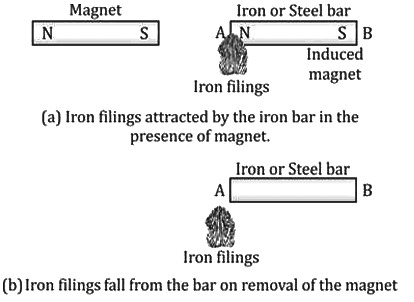
Induced Magnetism is Temporary
- The magnetism acquired by induction is temporary.
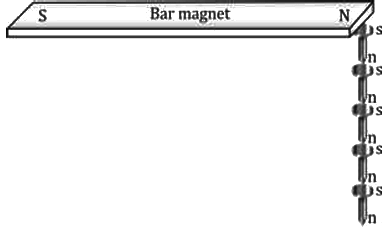
- The bar magnet induces magnetism in an iron nail which gets attracted by the magnet and clings to it. This magnetised nail magnetises the other nail near it by magnetic induction and attracts it.
- When the magnet is removed, the uppermost nail loses its magnetism first, and hence, all other nails lose their magnetism and fall down.
Magnetic Field Lines
- The space around a magnet in which the needle of a compass rests in a direction other than the geographic north–south direction is called the magnetic field.
- The direction of magnetic field at a point is the direction in which the needle of the compass rests when it is placed at that point. It is represented by drawing a line from the South Pole of the needle to its North Pole.
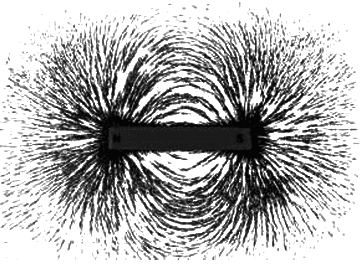
- A line of magnetic field is a continuous curve in the magnetic field such that the tangent at any point of it gives the direction of the magnetic field at that point.
Properties of Magnetic Field Lines
The magnetic field lines have the following properties:
- They are closed and continuous curves.
- They are directed from the North Pole towards the South Pole of the magnet.
- The tangent at any point on a field line gives the direction of the magnetic field at that point.
- They never intersect with one another.
- They are crowded near the poles of the magnet and are separated near the middle of the magnet.
- Parallel and equidistant field lines represent a uniform magnetic field.
Magnetic Field of the Earth
Our Earth has a magnetic field associated with it, and it behaves like a magnet. The existence of the Earth's magnetic field is based on the following facts:
- A freely suspended magnetic needle always rests in the geographic North–South direction.
- An iron rod buried inside the Earth along the North–South direction becomes a magnet.
- Neutral points are obtained on plotting the field lines of a magnet.
- A magnetic needle rests making different angles with the horizontal when suspended at different places of the Earth.
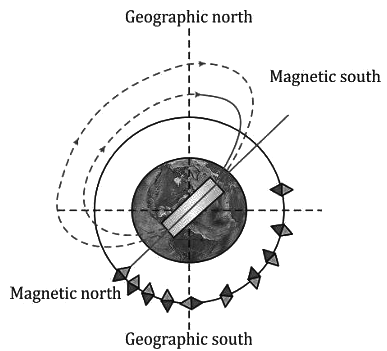
The two places where the magnetic needle becomes vertical are called the magnetic poles, and the line joining the two places where the magnetic needle becomes horizontal is called the magnetic equator.
Plotting the Non-Uniform Magnetic Field of a Strong Bar Magnet and Neutral Points
The figures below show non-uniform magnetic field lines: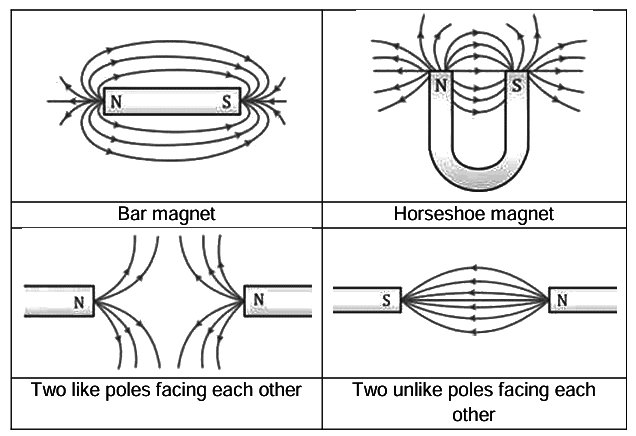
When The Given Magnet Is Placed With Its North Pole Pointing Towards North:
The magnetic field lines obtained in this position are shown in the figure below which are due to the combined effect of the magnetic field of the magnet and the Earth's magnetic field.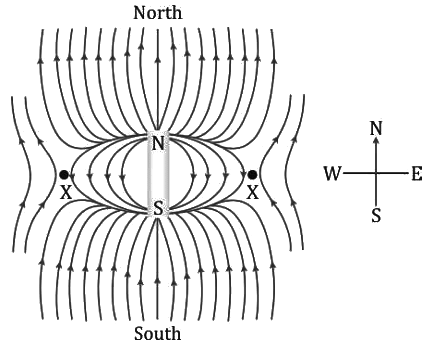
When The Given Magnet Is Placed With Its South Pole Pointing Towards North:
The magnetic field lines obtained in this position are shown in the figure below which are due to the combined effect of the magnetic field of the magnet and the Earth's magnetic field.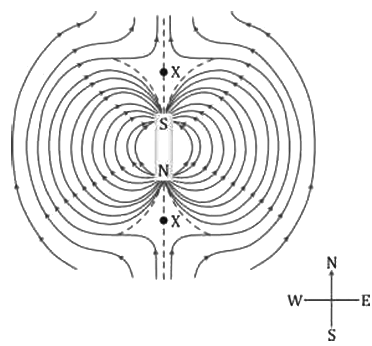
From the above figures, we can conclude that (for both the positions)
- The magnetic field lines near the magnet are curved, and they are mainly due to the magnetic field of the magnet which is much stronger than the magnetic field of the Earth. The magnetic field lines at distant points are parallel to each other and are mainly due to the Earth's magnetic field.
- There are two points equidistant from the centre of the magnet where the magnetic field of the magnet and the horizontal component of the Earth's magnetic field neutralise each other. These are the neutral points.
Neutral Points
- Neutral points are the points where the magnetic field of a magnet is equal in magnitude to the Earth's horizontal magnetic field, but it is in the opposite direction. Thus, the resultant magnetic field at the neutral points is zero.
- When the North Pole of the magnet faces the geographic North: The neutral points are situated symmetrically on either side of the magnet at equal distances from the centre in the east–west direction.
- When the South Pole of the magnet faces the geographic North: The neutral points are situated symmetrically on either side of the magnet at equal distances from the centre in the North–South direction.
The document Revision Notes: Magnetism | Physics Class 9 ICSE is a part of the Class 9 Course Physics Class 9 ICSE.
All you need of Class 9 at this link: Class 9
|
9 videos|63 docs|10 tests
|
FAQs on Revision Notes: Magnetism - Physics Class 9 ICSE
| 1. What is induced magnetism and why is it temporary? |  |
Ans. Induced magnetism occurs when a magnetic material becomes magnetized in the presence of an external magnetic field. This magnetization is temporary because once the external magnetic field is removed, the material loses its magnetism and returns to its original, non-magnetic state. This phenomenon is due to the alignment of magnetic domains within the material that only persists while the external field is present.
| 2. What happens when a magnet's north pole is placed towards the Earth's north? |  |
Ans. When a magnet's north pole is pointed towards the Earth's north, it experiences a repulsive force because the Earth's magnetic north is actually a magnetic south pole (due to the opposite nature of magnetic poles). This means that the north pole of the magnet will try to align itself in the opposite direction, leading to a stable position where the magnet is not directly pointing towards the geographic north.
| 3. What occurs when a magnet's south pole is oriented towards the Earth's north? |  |
Ans. When a magnet's south pole is directed towards the Earth's north, it will experience an attractive force. This is because the south pole of the magnet is attracted to the Earth's magnetic north pole. The result is that the magnet will align itself with the Earth's magnetic field, allowing the south pole to point towards the geographic north, creating stability.
| 4. How can we demonstrate induced magnetism in a classroom setting? |  |
Ans. Induced magnetism can be demonstrated in a classroom by using a small iron nail and a bar magnet. By stroking the nail with the magnet in one direction for several strokes, the nail temporarily becomes a magnet itself, exhibiting induced magnetism. Once the magnet is removed, the nail will lose its magnetism, showcasing the temporary nature of induced magnetism.
| 5. What are the practical applications of induced magnetism? |  |
Ans. Induced magnetism has several practical applications, such as in the operation of transformers and electric motors. These devices rely on the principle of induced magnetism to function efficiently. Additionally, it is used in magnetic storage devices, where data is stored by inducing magnetism in tiny magnetic domains. This principle is also crucial in various electromagnetic devices and machinery.
Related Searches





















